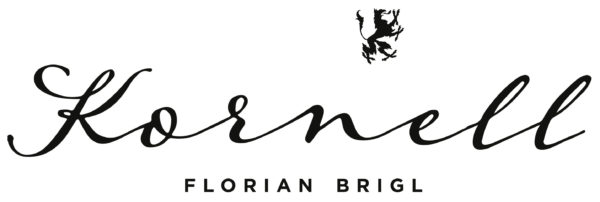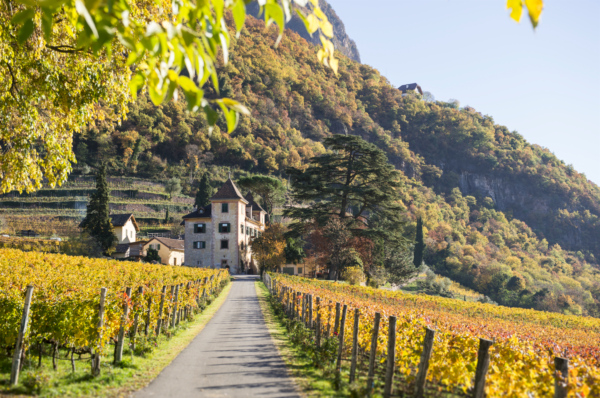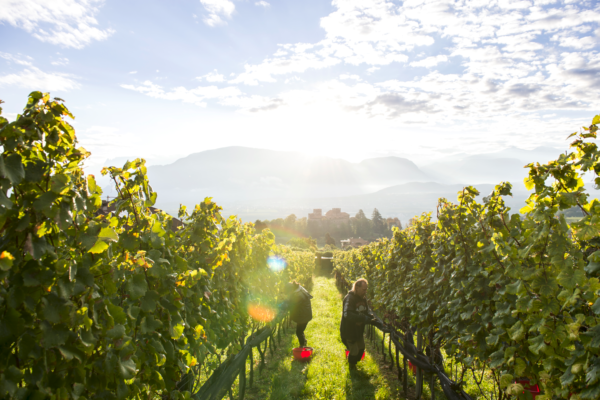
Family History

Florian Brigl, Owner
The Brigl family history has been intertwined with viticulture and oenology for centuries. The oldest family records date back to 1309, and substantial evidence indicates that as far back as the 16th century, winemaking was practiced by the family in the nearby town of Girlan.
After serving as a monastery from 1912 to 1927, the Kornell residence (formerly known as “Grosskarnell”) was acquired by the Brigl family in 1927. While at first the grapes harvested on the estate were delivered to the historic family cellars in Girlan, Friedrich Brigl (great uncle of Florian Brigl) founded the Brigl winery in the 1950s. Not long after, in the late 1960s, he ceased all viticultural activities, and the cellars were closed.
Today, Florian Brigl is managing Weingut Kornell. After inheriting the estate from his father (Leonhard Brigl) in 1996, he has followed in his great uncle’s footsteps and become a winemaker. In 2001, for the first time in 30 years, Kornell’s cellars were filled with life again. Since then, it has been a self-bottling, independent winery, with winemaking helmed by Marco Chisté.

Kornell Winery
Originally constructed in the 11th century, the Kornell estate is located in Siebeneich, a historically and archaeologically important area in the southern Alpine region. Excavations suggest that agricultural activity has been conducted in this area for over 2,000 years, with Siebeneich being one of the most important red wine suppliers for the ancient Roman Empire. Today, the estate comprises the surrounding vineyards and the ruins of the ancient castle “Greifenstein”, located on top of the mountain just behind the winery, whose flag bears the image of a griffin. Over 30 years ago, Friedrich Brigl chose this same griffin to be printed on every wine label as a symbol of their past, present, and future.
Vineyards
Porphyritic weathered soils, southern-facing slopes, and a Mediterranean climate characterize the terroir surrounding the Kornell estate. They provide the foundation for powerful yet elegantly structured red wines. Vineyards across the valley feature eastern-facing slopes, with soils constituted predominantly of chalk and limestone. With altitudes varying from 400 meters up to 800 meters, and a cool, Alpine climate, they produce grapes best suited best for straight-forward, minerally white wines.
The diversity in soils and climate allows Kornell to cultivate various grape varieties, ranging from Sauvignon Blanc, Pinot Blanc, Pinot Gris, Chardonnay, and Gewürztraminer, to Merlot, Cabernet Sauvignon, Pinot Noir, and Lagrein. All of their vines are pruned according to the Guyot method.
Vine and wine management on the Kornell estate is characterized by the use of natural resources. The fundamental idea underlying all viticultural decisions is “as little as possible, but as much as necessary”.
The total production area of the winery amounts to roughly 30 hectares. Apart from the vineyards, there are 80 hectares of forest, 15 hectares of fruit orchards, and 2 hectares of chestnut trees that also belong to the estate.

Cellar and Wines
The main requirement for elegant, harmonically structured wines is healthy and optimally matured grapes. Kornell believes that wines are created in the vineyard, not in the cellar.
They take great care when processing the grapes. The white wines, Cosmas Sauvignon Blanc, Eich Pinot Blanc, Gris Pinot Grigio, and Damian Gewürztraminer are 100% produced in steel tanks. Following 10-12 days of controlled fermentation, they mature in stainless steel tanks for a minimum of 5 months. After one month of bottle aging, they are released for sale.
The house red wines Greif Lagrein, Zeder Cuvée, and Marith Pinot Noir are carefully fermented in steel with must contact for 12 days. Maturation takes place in used barriques or large oak barrels in the old wine cellars for about 7 months. After two months of bottle aging, they are released for sale.
The reserve wines Staffes Merlot, Staffes Cabernet Sauvignon, and Staffes Lagrein are each fermented in wooden vats with must contact for 12 days. Spontaneous fermentation may partially occur. Following 12 months of aging in the cellars in barriques, they are bottled and stored for a minimum of 14 months.
The single vineyards include Aichberg (location Eppan Berg), a cuvée of Pinot Blanc, Chardonnay, and Sauvignon Blanc aged in barriques; Oberberg Sauvignon Blanc (location Eppan Berg) is aged on fine yeast in steel; and lastly Kressfeld Merlot Riserva (location Siebeneich) is aged for 18 months in new barriques and stored for 3 years in the bottle.
Sustainability
As a family-run business, Kornell cares more than anything about the preservation and conservation of the land. While they are continuously searching for ways to improve, they are proud of the fact that their vineyards are 100% plastic-free. All materials used are naturally decomposable, and they do not use compound fertilizers or herbicides. Instead, they use mechanical weed control.
The basis for great wines is healthy rootstocks, and the basis for healthy rootstocks is vigorous soils. That is why Kornell’s main focus is to enhance the vigor and hummus in the soils through targeted measures such as planting cover crops, using organic fertilizers only (e.g. compost), and minimizing pressure on the soil. 80% of the estate’s heating and warm water consumption is fueled by its own production. Thanks to the wood chips they derive yearly from their apple trees, the estate is able to sustain itself almost completely on its own.
Another important project for the future is the construction of a photovoltaic system (an electrical system that produces energy from the sun). This will allow Kornell to cover a good 70% of the winery’s energy needs independently.

Gewurztraminer Damian
Name: The winery is located at the intersection of Cosmas Street and Damian Street, which are named after the nearby church that is dedicated to Saint Cosmas and Saint Damian. Right next to the church, Kornell has a vineyard of Sauvignon and one of Gewürztraminer, from which this wine is produced.
First Vintage: 2007
Site: Settequerce/Terlano
Altitude: 300 m a.s.l
Soil: Porphyry weathered soil
Exposition: South facing slope
Slope: 15-20%
Pruning System: Guyot
Plant Density: 6,000 vines/ha
Yield: 65 hl/ha
Harvest: End of September
Vinification: Fermentation in stainless steel tanks
Aging: In stainless steel tanks for 5 months
Tasting Notes: Clear, bright, golden yellow color. Deep, fruity aromas of orange peel, some dried fruit and marzipan, a hint of rose fragrance, and cinnamon on the finish. Inviting palate, with lively freshness, juicy fullness. Full-bodied.
Food Pairings: Asian cuisine, curries, and bacon
Cellaring Potential: 5 years
Serving Temperature: 11-13°C

Pinot Bianco Eich
Name: “Eich” is the German word for “oak”. This is a reference to the name of the village, Sevenoaks, which the locals often just call Oaks.
First Vintage: 2009
Site: Settequerce/Terlano
Altitude: 300 m a.s.l
Soil: Porphyry weathered soil
Exposition: Southwest facing slope
Slope: 10-25%
Pruning System: Guyot
Plant Density: 6,000 vines/ha
Yield: 65 hl/ha
Harvest: End of August
Vinification: Fermentation in stainless steel tanks.
Aging: In stainless steel tanks for 5 months.
Tasting Notes: Brilliant straw yellow color. Multilayered bouquet with notes of ripe apricot, yellow apple, honey, and a touch of green mango. Powerful on the palate, with a dry structure. Mineral, saline notes and a pleasant acidity; juicy and stimulating with a long and persistent finish.
Food Pairings: Risotto, wild game.
Cellaring Potential: 5 years
Serving Temperature: 11-13°C

Pinot Grigio Gris
Name: “Gris” is the Latin word for Grey/Grigio, a reference to the Romans who founded the village the winemakers live in over 2,000 years ago.
First Vintage: 2015
Site: Pianizza di Sopra, Caldaro
Altitude: 350-400 m a.s.l
Soil: Gravelly soil with a high proportion of clay
Exposition: Southeast facing slope
Slope: 15%
Pruning System: Guyot
Plant Density: 6,000 vines/ha
Yield: 50 hl/ha
Harvest: Early September
Vinification: Fermentation in stainless steel tanks
Aging: In stainless steel tanks for 5 months
Tasting Notes: Bright yellow color with amber highlights. Pronounced fruity aromas of Kaiser Alexander pears and yellow peach. Scent of a freshly cracked coconut, and a hint of hay flowers. Full-flavored, well-structured, and elegant with a lively freshness, juicy fullness and vibrant minerality.
Food Pairings: Cheese dumplings, spinach ravioli, wildfowl dishes
Cellaring Potential: 5 years
Serving Temperature: 11-13°C

Pinot Noir Marith
Name: “Marith” was the first documented family name in the late 1190s.
First Vintage: 2008
Site: Mazzon, Caldaro
Altitude: 250 m a.s.l.
Soil: Gravelly soil with a high proportion of clay
Exposition: West facing slope
Slope: 10%
Pruning System: Guyot
Plant Density: 6,000 vines/ha
Yield: 65 hl/ha
Harvest: Mid-September
Vinification: Fermentation in big barrels
Aging: Aging in big barrels for 6 months
Tasting Notes: Bright, lively ruby red color. Fruity and elegant aromas of berries, raspberry and strawberry, with delicate spice. Fresh and stimulating on the palate, with soft tannins, lively acidity, and a juicy finish.
Food Pairings: Pasta dishes, white meats, bacon, charcuterie.
Cellaring Potential: 7 years
Serving Temperature: 12-14°C


